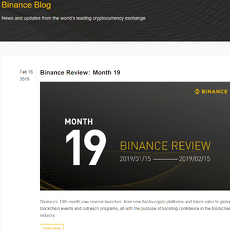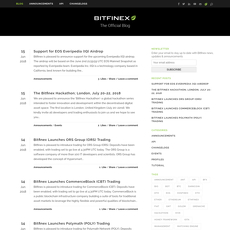Paxful Blog Review
Paxful Blog
blog.paxful.com
Paxful Blog Review Guide: Is It Worth Your Bookmark? (With FAQ)
Do you ever get the feeling you’re drowning in crypto content, but still have no idea who to trust? With thousands of blogs, news sites, and “gurus” popping up every day, it’s tough knowing where to turn—especially if you want real info and not just recycled hype. Is the Paxful Blog one of the few worth your attention, or just another noise in the crowd?
If you’re hunting for a trustworthy take on all things Bitcoin, you’ve probably run into sites that promise the world but leave you more confused than when you started. So, does Paxful’s blog actually help beginners dodge scams and give experienced traders a real edge? Let’s check it out, starting with what’s broken in today’s crypto information scene.
What's Wrong With Most Crypto Info Out There?
Let’s be real—so many crypto news sites feel copy-paste and everyone’s an “expert” after watching one YouTube video. You’ll find:
- Shallow analysis: Headlines with little substance. Big news breaks, but nobody explains how it affects you.
- Lots of hype, little clarity: Remember the 2021 “ALTSEASON” craze? Everyone screamed “buy this coin!”—few explained the risks. (According to a Brookings study, market hype fuels bad decision-making.)
- Biased reviews: Sponsored posts everywhere. It’s tricky to tell when you’re reading a real review or just a paid promo.
That’s why finding a trustworthy blog matters. You want info that goes past the surface, shares firsthand experiences, and cuts through the marketing speak.
How This Review Will Help You
Here’s my promise: I’m going straight to the source to answer the hot questions people search for, like:
- Why is Paxful banned in some places?
- Can you get scammed using Paxful, and how safe is it?
- Is this blog worth following for real market tips and beginner guidance?
And crucially, I’ll look at how the Paxful Blog compares to the flood of crypto advice out there, so you’ll know if it can actually help you—or if you should look elsewhere.
Why the Blog You Choose Matters
Picking the right crypto blog isn’t just about catching news—it’s about staying safe, making smarter trades, and actually learning enough to spot opportunities before everyone else. If you’ve ever lost money on a bad tip or missed a trend because you trusted the wrong headlines, you know how painful that can be.
Pro tip: According to Chainalysis, scams and misinformation still cause billions in crypto losses every year (source: Chainalysis Crypto Crime Report 2023). The blogs you choose are your first line of defense.
Ready to see if the Paxful Blog gets it right—or if it’s just marketing fluff? Let’s dig in and see what makes a crypto blog actually valuable. (Curious what kinds of content Paxful actually puts out, and how current it is? That’s what’s next!)
What Is the Paxful Blog & What Does It Offer?
Let’s get right to it—what’s the deal with the Paxful Blog? If you’re into crypto, you know how overwhelming it can be to sort real info from the generic noise. Paxful’s blog claims to be the spot for fresh updates and practical crypto education, but does it really deliver?
Overview of the Paxful Blog
First things first: Paxful’s blog is the official megaphone for everything happening on their exchange. It’s not just PR spin—at least, not always. Here’s what I actually see there:
- Step-by-step guides on how to use main features, like wallet security or payment options.
- Breakdowns of platform updates—think feature releases, maintenance alerts, and new partnership announcements.
- Safety tips and scam prevention advice for trading on Paxful (useful for anyone, honestly).
- Market insights—like trends in Bitcoin adoption or how global events are shaking up crypto.
One recent example? When Paxful rolled out an automatic KYC system, they didn’t just drop it silently; there was a full walkthrough explaining what changed and why it might impact your trading limits. Not every exchange is this upfront.
Who Is It For?
You might wonder, “Is this just for hardcore Paxful fans?” Actually, the blog reaches beyond just its registered users. If you’re brand new—never bought Bitcoin, just heard the term "P2P trading"—there’s a whole batch of beginner explainers to help you decode crypto lingo and nitty-gritty steps.
It’s just as relevant if you’re still on the fence about Paxful or peer-to-peer exchanges in general. There are full articles dedicated to understanding wallets, picking payment methods, and even weighing Paxful against other platforms.
“The best time to learn about security is before someone tries to scam you.”
This sticks with me every time I see a new blog post in their Security section.
Types of Content You’ll Find
The content is split across a few key lanes, making it easy to hunt down exactly what you’re after:
- Beginner Guides: Think ‘Bitcoin 101’ posts, wallet setup how-tos, and basic explanations for anyone dipping a toe into crypto.
- Security Alerts: Instant heads-up on new scam tactics or changes to Paxful’s security policies. Super important when crypto hacks make headlines routinely.
- Product & Feature Updates: Posts about new payment integrations, app launches, or design tweaks that could affect your trading experience.
- Market Commentary: Broad stories about the crypto industry, including regulatory news and Paxful’s role in global adoption (sometimes with stats or references).
For example, there was a recent explainer on the surge of crypto adoption in countries facing inflation, showing how Paxful fits into bigger economic changes. This is the kind of info that’s not just “here’s our update” but actually insightful for broader crypto users.
How Often Is It Updated?
Here’s the kicker: crypto never sleeps, and neither should the info you rely on. Paxful’s blog usually pushes fresh posts at least a couple times a month—sometimes more if there’s a major event or update. Compare that with some crypto blogs that go quiet for months and you’ll see how crucial this is.
It’s not just about frequency, though. Their updates often correspond with real-world changes. If a wallet bug pops up, or if there’s a new regulatory twist, you’ll find a post explaining what it means to you practically—often before it hits big news sites. That’s what makes you feel like you’re not left in the dark, especially for something as volatile as Bitcoin trading.
So, with all these features and topics—does Paxful’s blog actually bring an edge, or is there more to the story? There’s one thing I keep asking: does helpful content really outweigh what’s missing? Let’s check out where the Paxful Blog shines… and where it might fall short (and yes, a few surprises) in the next section.
The Benefits & Downsides of Reading the Paxful Blog
The Good: Why It Stands Out
Let’s be real—most crypto blogs throw around buzzwords and leave you more lost than before you started. The Paxful Blog isn’t like that. What I’ve noticed is that they keep things practical. The guides aren’t just “What Is Bitcoin?”, they get into step-by-step walkthroughs for both new and experienced users. For instance, when Paxful rolled out new fee policies or tweaked how sellers get rated, you didn’t have to hunt the info down. The team posts it right on the blog, in plain English.
This is what I like:
- Clear language for beginners: No long tangents or confusing charts. If you’re new to peer-to-peer (P2P) trading, you won’t get lost—real examples, screenshots, and “here’s exactly what to click” advice.
- Timely updates, direct from the source: Not gossip, not rumors—actual staff explaining changes and what you need to know. It’s the kind of transparency that goes a long way in crypto, where trust is everything.
- Useful security reminders: There’s a whole section dedicated to fraud prevention, scam alerts, and practical safety tips. As one post put it, “Every click is a decision—make sure yours are smart, not rushed.”
- Balanced mix of quick reads and deep guides: Whether you have five minutes or want to research for an hour, there’s content for both types of readers.
I’ve seen plenty of users mention how the guides about wallet safety or troubleshooting login problems actually saved them from losing money. One Reddit user even said,
“I learned about Paxful security tips from their blog before my first trade—still never got scammed years later.”
That’s not something you hear often about crypto blogs.
The Not-So-Good: What’s Missing
But let’s not sugarcoat it—this blog isn’t perfect (and honestly, no crypto blog is). One thing I can’t ignore is the way a lot of articles are tailored to make Paxful look like the hero. Sometimes you get the feeling you’re reading more of a marketing campaign than objective advice. For example, while updates about platform changes or security are genuinely helpful, don’t expect deep market analysis or neutral comparisons with other exchanges.
- Lack of in-depth analysis: If you’re hoping for Bitcoin price predictions, deep data breakdowns, or independent research, this isn’t the spot. You’ll find more of that in places like Messari or CryptoSlate, not here.
- Heavily brand-focused: There’s some bias, and it rarely explores solutions or services outside Paxful. If you want the “cons” alongside the “pros,” you’ll need to check additional blogs.
- Not as wide a scope on general crypto: The focus is on Paxful, so don’t expect much on Ethereum, DeFi, NFTs, or global regulatory updates unless it connects directly to Paxful’s services.
It’s a classic double-edged sword—what makes the info trustworthy is that it’s from the source, but that also means it can have blind spots. I’d love to see more cross-comparisons or third-party references, rather than strictly talking about the Paxful ecosystem.
Who Should Pay Attention and Who Might Want More
So who will actually get real use out of the Paxful Blog? If you’re just getting started and want a no-nonsense walkthrough on buying, selling, or keeping your Bitcoin safe, it’s genuinely one of the most user-friendly official blogs out there. You’ll skip a lot of rookie mistakes just by reading the basics before your first trade.
For more advanced folks, though, you’ll probably outgrow some of the posts pretty fast. Regular market news junkies or hardcore traders looking for deep research will need backup from more data-heavy sources. It’s a bit like using your bank’s blog—great for updates and important alerts about your account, but not where you’d go to learn about global economics.
If you lean on the Paxful Blog alone, you’re in safe hands for all things Paxful—but you’ll need to branch out to really master the crypto universe.
Ever wondered if something as simple as a blog could make or break your Bitcoin journey? Wait until you see what the top questions about Paxful reveal next—it might change how you think about crypto safety for good. Scroll down, and let’s clear up the biggest misconceptions and real safety questions you won’t find in the usual blog posts…
FAQs: Answers to the Top Searched Questions About Paxful
Why Is Paxful Banned (Or Unavailable) in Some Countries?
This one’s easily one of the most Googled (and whispered about) questions. So, why do you suddenly see “Paxful is not available in your region” when you try to sign up, especially if you’re in the US or some other places? It comes down tolegal and regulatory headaches.
Crypto platforms get run through a legal obstacle course, and sometimes—despite best intentions—it isn’t enough. In 2023, Paxful actually pulled out of the US entirely due to what they called “regulatory challenges.” What does that mean? Basically, local laws often require tons of compliance—everything from strict KYC (Know Your Customer) rules to having gigantic legal teams. If regulators aren’t happy, it’s game over.
Countries with harsh crypto laws or uncertain policies about Bitcoin are often off-limits. That’s why if you’re in places like New York, Texas, or Ontario, you might get blocked. Always check the official region list before getting your hopes up.
“When regulation meets innovation, friction is inevitable.”
Can You Get Scammed on Paxful? How Safe Is It?
Here’s some brutal honesty: Scams do happen on Paxful—just like on any peer-to-peer crypto platform. But the platform wants its users sharp, not sheep. The blog frequently shines the spotlight on common scam tactics like fake payment screenshots, phishing, and too-good-to-be-true offers. The real toolbelt, though, is packed inside their Paxful University safety guides.
- Never trade outside Paxful's escrow system.
- Watch for red flags, like rushed deals or mismatched usernames.
- Double-check links—phishing is everywhere.
Still, risk is never zero. There are always new scams out there, and no blog or platform can stamp out every single one. That’s why Paxful repeats their golden rule: if something feels off, walk away. Every week you’ll spot stories in Reddit and Trustpilot about deals gone wrong—so a healthy chunk of suspicion is your best friend.
How To Use Paxful: A Beginner’s Step-By-Step
Signing up and buying Bitcoin on Paxful is actually simple, but can feel like a minefield if you don’t know what to expect. Here’s the quick version, inspired by guides even total newbies can ace:
- Sign up with an email, phone, and password.
- Verify your ID (most regions require it).
- Add funds or start hunting for an offer—filter by payment method, seller rating, or currency.
- Choose a trustworthy seller—look for lots of positive reviews and history.
- Start the trade, chat in-platform, and follow the instructions exactly.
- Once payment is confirmed, the seller releases BTC from escrow straight into your Paxful wallet.
Is it really just a few clicks? For most people, yes. But your first time often feels nerve-wracking—that’s why reading up on each step before clicking anything is key.
What Fees Does Paxful Charge?
This one trips up a lot of folks. The basics: Paxful lets you send Bitcoin from wallet to wallet for free up to a certain amount each month. Go over the first five free sends? You’ll pay either $1 or 1% of the transfer amount, whichever is greater. Trades on the marketplace can mean different fees based on payment method. It’s all laid out in their official fee breakdown.
- External transfers (over the free limit): $1 or 1%, whichever is more.
- Marketplace trades: Usually, buyers pay no fee, sellers pay 1%.
- Using uncommon payment methods? Sometimes there’s an extra fee—watch for notices as you trade.
And yes, with big Bitcoin swings, always double-check before you hit send. Fees add up fast if you’re not paying attention!
What questions should you be asking before you trust your money to any crypto blog or platform? Or, even better—how do you actually know if a crypto blog is the real deal? That answer is coming up next, so keep reading and discover how Paxful’s blog—and others—really stack up.
How to Judge If a Crypto Blog is Actually Valuable (Including the Paxful Blog)
What Makes a Crypto Blog Worth Reading?
Let’s be real—the crypto world is full of noise. Anyone can start a blog, push out the latest headlines, or hype a shiny new coin, but that doesn’t mean you’ll actually get value from reading it. So, what separates a solid crypto blog from all the clickbait and fluff out there?
- Clear, Reliable Writing: If you find yourself re-reading sentences or untangling jargon just to make sense of things, it’s a sign to click away. Quality blogs make tough subjects easy—with plain language, examples, and a true explanation (not just rehashed PR). Misspellings, confusing layouts, and outdated info are instant red flags.
- Truth & Transparency: Look for sources, citations, and honest author opinions—not just disguised ads or promotional hype. When a blog consistently references real resources (like linking to Paxful Support or Paxful University), you know you’re getting facts, not assumptions.
- Beginner-Friendly Approach: Solid blogs break down tricky terms and steps for newbies, often using analogies, visuals, and real-life stories. Bonus points if they open up comments for questions—those back-and-forths often make for the best learning.
- Coverage & Specialty: The best blogs know their lane. Some (like corporate Paxful Blog) stick to their platform and product updates. Others cast a wide net—from Bitcoin to NFTs and DeFi. Pick what matches your needs. If you’re brand new, broader coverage helps; if you want advanced technical analysis, niche blogs often go deeper.
- Regular Updates: The crypto world never hits pause. A good blog keeps you in the know as things unfold, not weeks later. If you want to see this principle in action, check how quickly news breaks or changelogs are published.
- Reputation & Integrity: Some blogs strive for unbiased reporting, while others can’t stop promoting their sponsor’s latest token. I did a deep research guide on these signals over at our crypto blog section, analyzing which blogs genuinely care about your interests—not just boosting their own brand.
“Cryptocurrency is an evolving concept, which is evident in the growing number of terminologies and techniques emerging in the industry… It has become necessary to access portals where you can access up-to-date information about the happenings in the space and make necessary moves to capitalize on their impacts on market trends.”
That’s the philosophy that shaped how I rate and review crypto blogs in the first place. You want thoughtful, respected authors, a frictionless reading experience (ads and pop-ups are the enemy), and posts that never feel like copy-paste rewrites from yesterday’s headlines.
The Paxful Blog in Context
I’ve looked at 35+ top crypto blogs for a living (yes, really), so where does the Paxful Blog fit in this landscape? Here’s what stands out:
- Quality and Clarity: Paxful’s posts tend to be accessible, thanks to clear guides and step-by-step tutorials, especially for beginners looking to avoid common crypto traps.
- Speed and Updates: Updates are frequent—when regulations change or new features launch, you’ll often see announcements hit the Paxful Blog quickly.
- Objectivity: Let’s call it like it is—Paxful isn’t always fully neutral. Their content is heavy on what their platform offers. Compared to broader crypto blogs, it can feel more brand-focused. If you’re looking for deep market analysis or critical discussions around Bitcoin, DeFi, or regulation, you’ll sometimes come away wanting more.
- Inclusivity: There’s solid effort to address a wider audience, not just pros. But multi-language support or region-specific content is still limited. The best blogs on my crypto blogs list usually smash it here.
Paxful’s blog absolutely ticks off some key boxes—timely updates, helpful for new users, and the kind of platform-specific content that’s essential if you’re already using Paxful. On the flipside, it lacks the deep-dive, community-first feel of blogs run by independent researchers or crypto thought leaders. It’s best seen as a starting point or a supplement, not your sole research source.
Other Resources Worth Knowing
The smart move in crypto? Never stick to just one source. Consider balancing what you find on Paxful with these types of resources:
- Top Crypto News Sites – For up-to-the-minute updates and breaking headlines. These tend to summarize developments, but pairing them with blogs provides both speed and depth.
- Personal Crypto Blogs – Authors like Andreas Antonopoulos or Vitalik Buterin go way beyond company news and share real insights from years of experience.
- Deep-Dive YouTube Channels – Visual learners can’t miss out. Channels like Coffeezilla or Coin Bureau make even complicated concepts fun and totally understandable.
- Dedicated Reviews – Want a full roundup? My researched crypto blog list includes reviews of all the sites making a difference in the community—tracked for accuracy, bias, and genuine usefulness.
No matter how good one blog is, the best edge comes from stacking your sources and sharpening your critical thinking. Every time you get a new perspective, you get a little smarter in this wild, fast-moving industry.
But here’s a question—when is sticking to just the Paxful Blog enough, and when should you branch out? Should you ever fully trust a single platform’s content in this decentralized world, or is there a bigger strategy for crypto research? Let me break down the smartest way to use—and not over-rely on—crypto blogs in the next section…
Final Thoughts, Tips, & How To Get the Most Out of Crypto Blogs
When to Use the Paxful Blog—And When to Go Elsewhere
So here’s the bottom line: if you’re brand new to crypto or just getting comfortable with Paxful, the Paxful Blog is actually a great place to start. You’ll get plain-English guides, quick platform updates, and those first security basics everyone in crypto needs. It holds your hand through the simple stuff, like setting up your account or learning how trades work—something a lot of blogs totally skip.
But—and this is important—if you’re past the beginner phase or you’re hungry for broader strategies, case studies of real trades, or “what’s next” in the world of decentralized finance, you might not get everything you need there. For example, if you're curious about how the latest Bitcoin ETF news affects peer-to-peer marketplaces, or you want a deep breakdown on platform risks in emerging markets, you’ll need to look elsewhere.
Think of the Paxful Blog as your “crypto 101” class: perfect for your first semester, but not the whole university degree.
Stay Smart: Protect Yourself and Keep Learning
Here’s a fact: crypto changes fast, and what worked last year might be risky now. Don’t ever rely on one source—not even the most official-looking blog. Studies from the University of Cambridge and the Chainalysis crypto crime report both show that new scams appear every month, with different tricks each time. The sneakiest scammers literally count on people only reading one guide or blog.
So what should you do? Here’s what works for me and most pros I know:
- Cross-check advice: If the Paxful Blog tells you a new security tip, see if the same warning pops up on other platforms or on Chainalysis or CoinDesk.
- Look for “last updated” dates: Crypto is wild. If a guide is more than six months old, tech and regulations might already be different.
- Ask questions on Reddit or Twitter: Real traders will often spot issues or confirm if a platform update is legit or just hype.
- Bookmark a handful of trusted sources: I keep a short list—official blogs like Paxful’s, price trackers, independent analysts on YouTube, and of course, comparison sites like Cryptolinks.
Facts shift, rules update, and hacks sadly happen. If you make a habit of checking several places, keeping up with alerts, and questioning anything that sounds “too good to be true,” you’re miles ahead of most newcomers.
Wrapping Up & My Recommendation
After spending plenty of time skimming everything from the Paxful Blog to deep-dive forums and crypto podcasts, here’s my honest two cents: the Paxful Blog should probably be in your bookmarks if you’re a beginner or if you want the fastest platform news and straight-from-the-source guides. But don’t treat it as your only research spot.
Use it for:
- Spotting platform updates and account tips
- Easy tutorials for first-timers
- Security reminders and scam alerts (especially from the team itself)
But when you’re looking for market predictions, technical analysis, or are researching how crypto trends affect global users (think: regulations, hacks, advanced trading), pair it with big names like Messari or newsletters like The Block.
Crypto blogs are like wallets—have more than one, check what’s inside regularly, and don’t use the same one for your biggest risks.
Last tip: stay curious, assume change is coming, and never click any link or offer before you’ve checked it out in more than one place, with your own eyes. In crypto, caution is a strength, not a weakness.
Happy researching—and if you find smarter crypto blogs or tools, let me know in the comments below or hit me up through Cryptolinks. We’re all still learning, and that’s actually what makes this community so much fun.













